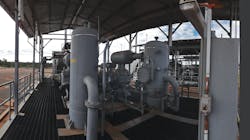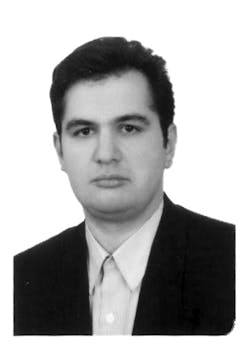Reciprocating compressors and reciprocating pumps are mainly used to produce a high discharge pressure that is either difficult or uneconomical for the centrifugal machineries or other types of machineries to achieve. They have been used in many services and applications. In reciprocating machineries (reciprocating compressors and pumps), the working piston(s) or plunger(s) are moving in a back-and-forth fashion. They can theoretically deliver the same adjusted volume regardless of the discharge pressure. In other words, ideally, they can discharge the same adjusted volume of fluid — independent of behavior of the downstream.
A major problem in reciprocating compressors and pumps is the pulsation of the flow due to the intermittent action of the piston and cylinder valves. The pulsating flow causes vibration in the piping and its supporting structure. The problems, issues and risks associated with this pulsation is quite complicated and widespread. There have been many complaints about pulsation of reciprocating machineries and particularly on the pulsation of flow in the associated piping in many plants and facilities. This is a widely reported area of concern and a hot topic in the flow movement industry.
This article discusses pulsation of flow in piping of reciprocating machineries. The focus is on practical guidelines and useful knowledge to avoid this major risk in fluid movement systems using reciprocating pumps and compressors.
Pulsation
The discharge from a reciprocating machinery is not continuous; rather, it is intermittent. Similarly, the suction flow to the machinery is also intermittent. The piston is pushed back and forth by the connecting rod connected to the crank, which is usually revolving at a constant speed. With a constant angular crank speed, the linear speed of the piston varies closely to a sinusoidal shape. If the connecting rod is infinitely long, then the piston speed follows a pure sinusoidal form. With a finite-length connecting rod, the piston speed tends to be slower than given by the sine curve at the side closer to the crankshaft and quicker toward the other side.
Because the pulsation problem involves the reciprocating machinery, pulsation vessels, piping systems and accessories in a multiple level of interaction, its adverse phenomena is difficult to determine. On one hand, some reciprocating machinery installations operate quite satisfactorily without a detailed pulsation study. On the other hand, many ordinary preventive pulsation studies do not necessarily always eliminate the pulsation problem.
Many plants and facilities have adopted a wait-and-see policy. If the system is not operating smoothly, then all types of questions are asked and used to solve the problem. The fact is, there are many reported problems due to pulsation. Once the piping starts shaking due to pulsation, the entire facility is also likely to shake. This could be a serious situation. In some cases, an immediate shutdown of the plant is required.
Multiple cylinders, interactions and variable speed
Many reciprocating machineries have more than one set of piston and cylinder. The cylinder can also be single-acting or double-acting. Double-acting means the piston is working both ways, having inlet and outlet ports at both ends of the cylinder. As flow is discharged from both sides of the double-acting cylinder or different cylinders to a common header, a combined volumetric pulsation is created. The combined pulsation flow theoretically averages out by the multiple outlets spaced at strategically straddled crank phase angles. More cylinders result in a higher pulsation frequency, but lower pulsation amplitude, in theory. However, there could be interactions. Therefore, the pulsation matter is more complicated where there are different sources of pulsation, as these can interact with each other.
Similarly, when a part-load method is used, it can usually complicate the pulsation patterns. Another source of complication is the speed variation. There have been variable speed reciprocating machineries, and the issues and problems with their pulsation are more complicated.
Cyclic shape and harmonics
The dominant (or fundamental) pulsation frequency is the crankshaft speed, multiplied by the number of actions of piston(s) or plunger(s) in each revolution. For instance, in a single-cylinder double-acting machinery, the dominant pulsation is at two cycles of pulsation per one crankshaft revolution. This fundamental (or dominant) pulsation frequency is important, as highest excitations are usually experienced in this frequency.
In practice, the shape of the pulsation has deviated from sinusoidal. The shape of the reciprocating compressor pulsations is irregularly shaped. Because of its imperfect but nevertheless cyclic shape, the pulsation is regarded as the combination of many sinusoidal pulsations at crankshaft rotation frequency, fundamental frequency and their higher harmonic frequencies.
Compressors versus pumps
In a compressor, the gas should be first compressed from the inlet pressure to the outlet pressure before it is discharged to the outlet system. Because of its compressible nature, it requires the piston to move to a specific point to compress the gas to reach outlet pressure. The gas is then discharged volumetrically according to the speed of the piston. This assumes that the outlet pressure maintains a constant pressure without being influenced by the discharge of the compressor.
The discharge shape of the pump is quite different due to a practically incompressible nature of the pumped liquid. In a pump, the liquid starts to discharge almost instantaneously as the piston starts to move. Therefore, the volumetric shape is similar to the sinusoidal shape without the initial silent period. In high pressures, liquid would become slightly compressible. In very high pressures, gases become dense, and their behavior would be similar to dense fluids.
Acoustic and structural resonances
Acoustic and structural resonance should be avoided. The pulsation flow has two potential resonance mechanisms that need to be avoided. First, the pulsation pressure wave can generate acoustic resonance if the length of any discontinuous section in the piping has an acoustic natural frequency that coincides with the pulsation frequency.
Another potential problem is the structural resonance of the piping natural flexural vibration frequency with the pulsation pressure frequency. Acoustic resonance can be largely avoided by running a study of the piping configuration and equipment performance. Regarding piping structural resonance, one of the tactical solutions is to support the piping in such a way that changes the natural frequency of the piping to be higher than the pulsation frequency and not near its harmonics. However, this is usually challenging, as the pulsation has many harmonic modes. Too often, it is impossible to provide the piping so that all piping natural frequencies are located away from all pulsation frequencies (including harmonics).
A commonly used policy is to make the piping so stiff that its fundamental frequency is at least 50% higher than the fundamental frequency of the pulsation. However, even this approach is difficult to achieve in some cases. A more practical rule-of-thumb approach is to support the piping with support spacing reduced to one-half of the standard spacing.
Pulsation vessels (pulsation bottles)
At a constant speed of machinery and a constant setting of the capacity control system, the average mass flow passes the entire system can be assumed unchanged. However, the volumetric pulsation entering the pulsation vessel (pulsation bottle) is partly absorbed by the volume (capacitance) of the vessel (bottle), leaving the rest to discharge through the piping. The pulsation flow to the piping creates the pulsation pressure, which produces the pulsation force to shake the piping system.
A peak-to-peak pulsation pressure is needed to push the peak-to-peak volumetric pulsation flowing through the piping. This same pressure pulsation also compresses the fluid volume inside the vessel (bottle) to make room for some of the incoming pulsation flow. The bigger the vessel volume and the higher the fluid compressibility, the more incoming pulsation is absorbed by the bottle, leaving less pulsation being transmitted through the piping.
For incompressible fluids such as the ones handled by the pump, the portion of pulsation absorbed by the pulsation vessel bottle is negligible. Therefore, for pumps, the residual pulsation flow is very close to the original pulsation flow.
For compressor installations, the residual pulsation is roughly determined by an attenuation factor which is estimated as 1/(1+n), where “n” is the ratio of the pulsation bottle volume to the piston displacement volume. For instance, if the volume of the pulsation bottle is 7 times the total cylinder displacement, pulsation is roughly attenuated to around 0.125 (1/8) times the original value. Thus, the bottle achieves roughly an eightfold reduction of the potential pulsation pressure.
The pulsation bottles used by the reciprocating pump is more complicated than the simple conventional bottle. This is mainly due to the incompressible nature of the liquid. For liquid flow, a gas volume is generally needed to absorb the pulsation. The gas-filled surge chamber is one such example. With the compressible chamber, a large portion of the pulsation flow is absorbed by the compression or expansion of the gas volume. Thus, the residual pulsation flow through the piping is substantially reduced. Such a pulsation dampener can be in the form of a bladder-type dampener, gas-filled surge chamber or suction standpipe.
Piping connected to reciprocating machineries
When dealing with a reciprocating compressor or pump, the piping can be excited by pulsation or vibration. Therefore, special provisions are needed for these piping systems. The first consideration is an independent support system. The piping vibration can propagate to the entire facility or plant when the piping is supported from a common structure. Therefore, it is important that proper spaces have been allocated so the piping can be independently supported (independent from reciprocating machinery and independent from all other facilities).
Furthermore, the supports offered should have sufficient stiffness to effectively control the dynamic motion of the piping and elevate the natural frequencies to high levels. Stiff supporting members, such as concrete sleepers located at grade level, should be used if practical.
Another consideration is secured clamping. The connection between the piping and the support structure is critical to the effectiveness of the support. A good connection starts with good clamps, which is the first link between the piping and support. Without a good connection, a purposely built heavy support structure is not worth the cost. The clamp should be stiffened and provided with belting material to offer some damping effect in addition to securing a good connection. Some successful support types have been provided with two squeezing wedges to ensure a snug fit of the pipe and clamp. This is often used in large piping.
Different types of special supports have been used for piping of reciprocating machineries. In general, simple and strong systems are preferred. It is important to investigate how support is reacted in each direction. Attention is needed for details. A key point is, while the support scheme should be stiff, thermal movements should be properly considered. Thermal movements of the piping should be accommodated without causing overstress. However, most vibration piping operates at a rather moderate temperature. If the rated temperature is overly conservative, the piping might be too flexible to prevent vibration. Therefore, it is important to set a realistic rated temperature.
If vibration or pulsation is suspected, priority should be given to these issues, and only realistic thermal movements and stresses with absolutely minimum margins should be considered. For many continuously operated processing plants, thermal load cycles only once or twice a year, yet the vibration stress occurs hundreds of cycles per minute.
Amin Almasi is a lead mechanical engineer in Australia. He is a chartered professional engineer of Engineers Australia (MIEAust CPEng – Mechanical) and IMechE (CEng MIMechE) in addition to a M.Sc. and B.Sc. in mechanical engineering and RPEQ (Registered Professional Engineer in Queensland). He specializes in mechanical equipment and machineries including centrifugal, screw and reciprocating compressors, gas turbines, steam turbines, engines, pumps, condition monitoring, reliability, as well as fire protection, power generation, water treatment, material handling and others. Almasi is an active member of Engineers Australia, IMechE, ASME and SPE. He has authored more than 150 papers and articles dealing with rotating equipment, condition monitoring, fire protection, power generation, water treatment, material handling and reliability. He can be reached at [email protected].



